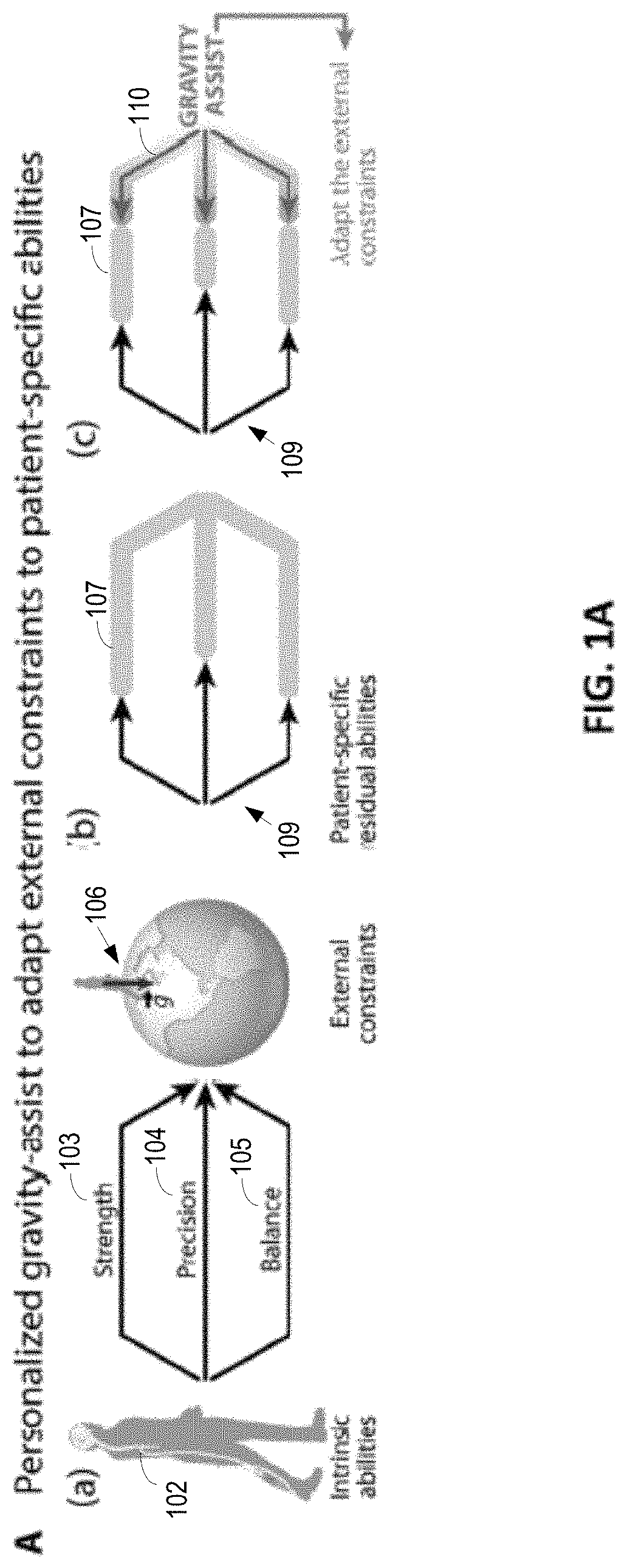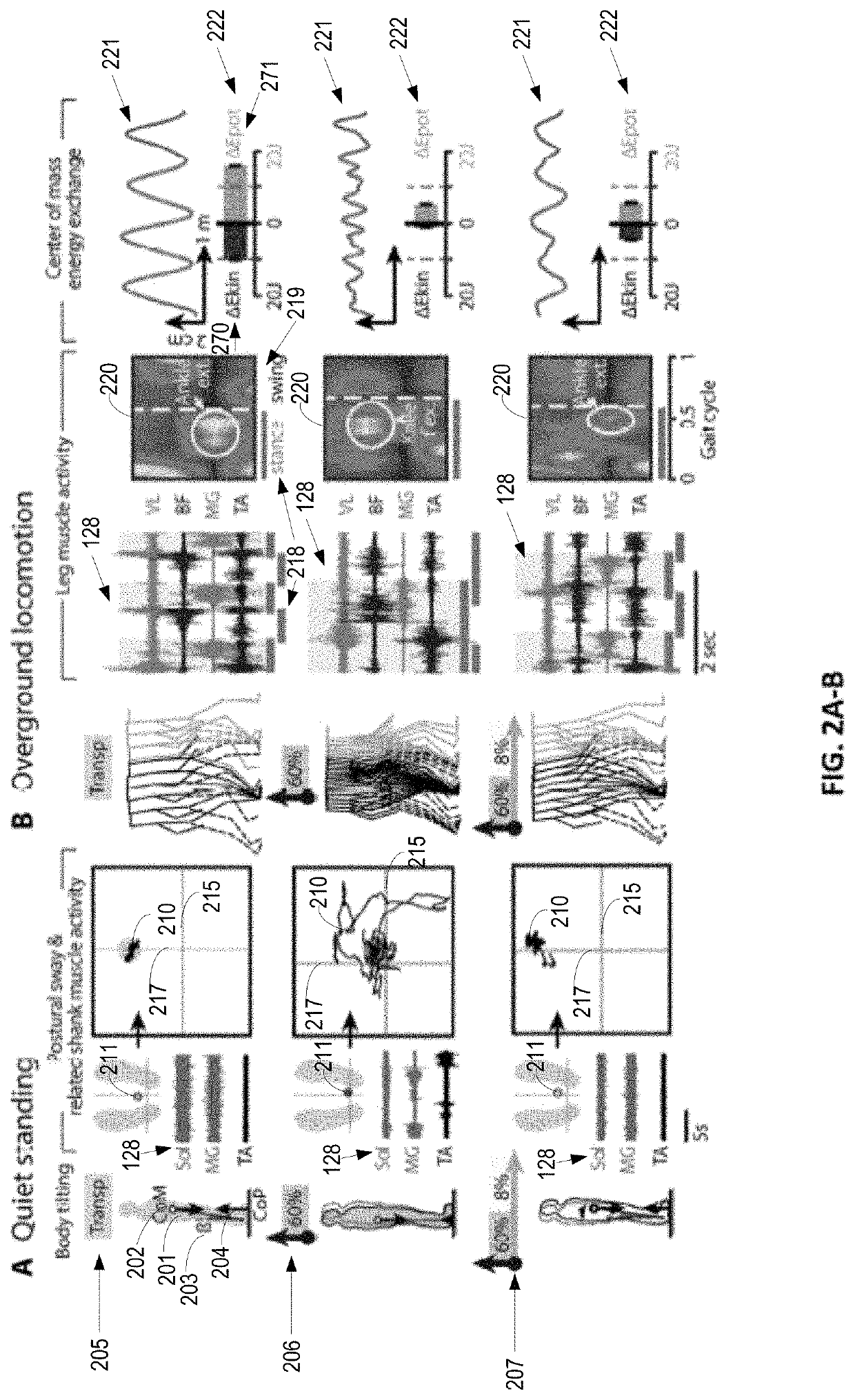Apparatus comprising a support system for a user and its operation in a gravity-assist mode
a technology of support system and user, which is applied in the field of apparatus comprising a support system for a user and its operation in a gravity-assist mode, can solve the problems of neurologically impaired individuals imposing challenging conditions, affecting the function of the apparatus, and affecting the ability of the apparatus to perform normal activities, so as to promote activity-dependent neuroplasticity and motor recovery, and minimize the mechanical impact of the trunk suppor
- Summary
- Abstract
- Description
- Claims
- Application Information
AI Technical Summary
Benefits of technology
Problems solved by technology
Method used
Image
Examples
example 1
Experimental Protocol 1: Properties and Validation of the Neurorobotic Platform
[0322]Eight healthy subjects were recorded during locomotion without and with robot along a straight or curvilinear path projected on the floor using the augmented reality system. They were asked to walk naturally at their own selected pace. They wore the harness during both conditions. The robot was configured in transparent mode, which corresponds to the minimal upward force (4 kg) necessary to enable robot-subject interactions. For each condition, a total of 10 steady-state gait cycles were recorded and analyzed.
example 2
Experimental Protocol 2: Impact of Upward and Forward Forces on Posture and Gait
[0323]Five subjects were first recorded during quiet standing while attached to the robotic interface. They were asked to stand quietly with eyes open. Each foot was positioned on its own force plate with a standardized location and orientation (58). The distance between the medial side of the heels was set at 8.4 cm and the external rotation angle of the feet was kept at 9 deg with respect to the sagittal plane. The subjects were instructed to center and stabilize their center of foot pressure that was projected on the floor in real-time through the augmented reality system. This visual biofeedback was removed during recordings. The subjects were then asked to stare at a visual reference mark projected on the floor 3 m straight ahead in front of them. Each trial lasted 20 seconds. Two trials were collected for each upward and forward force.
[0324]The same subjects were then evaluated during locomotion ac...
example 3
Experimental Protocol 3: Design of Gravity-Assist Algorithm: Personalization of Upward Force
[0325]Nine subjects with a SCI or a stroke were tested during quiet standing over the maximum possible range of upward forces under the same conditions as explained in Experimental Protocol 2. For each upward force, two trials were collected that each lasted 20 s and were separated by 1 min. Each trial was then divided into a set of 20 windows of 1 s over which 15 kinematic, kinetic and electromyographic parameters were computed. A PC analysis was applied on these variables to determine the optimal upward force for each subject.
[0326]The this dataset and results were used to build an artificial neural network that calculated the necessary correction of upward force to provide each subject with optimal upward force. The artificial neural network integrated the kinematic and kinetic parameters (n=12, 10 seconds of recording). 13 learning rules and 11 structures were tested with different number...
PUM
 Login to View More
Login to View More Abstract
Description
Claims
Application Information
 Login to View More
Login to View More - R&D
- Intellectual Property
- Life Sciences
- Materials
- Tech Scout
- Unparalleled Data Quality
- Higher Quality Content
- 60% Fewer Hallucinations
Browse by: Latest US Patents, China's latest patents, Technical Efficacy Thesaurus, Application Domain, Technology Topic, Popular Technical Reports.
© 2025 PatSnap. All rights reserved.Legal|Privacy policy|Modern Slavery Act Transparency Statement|Sitemap|About US| Contact US: help@patsnap.com



